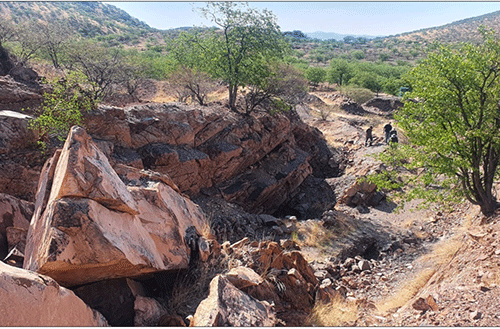Osino Resources, the Canadian mining company exploring for gold in the Karibib area since 2017, recently announced the detection of significant gold deposits at its Eureka greenfields exploration. The major finding was made approximately 35km north-east of the company’s Ondundu Gold Project, which is approximately 130km northwest of Osino’s flagship Twin Hills Project, situated just north of Karibib. Ondundu is 100% owned by Osino.
Dave Underwood, Osino’s VP Exploration, commented: “The Eureka licence was identified in 2019 as part of a regional target generation exercise based on structure and geology. There has been no previous exploration in the area, and there are no known local gold deposits. The licence was initially explored using soil and rock chip sampling, which produced a gold anomaly at surface”.
He continued: “This greenfields discovery in an area of no known gold occurrences is testament once again to the target generation ability of the Osino team, and the effective, systematic exploration our team is known for”.
Underwood said this latest Eureka discovery was an exciting surprise and unusual in the Namibian gold deposit context.
“We have just scratched the surface of this new gold project. The mineralisation is open in all directions, and there are several additional targets which remain to be drilled. We are very bullish about Eureka and what it could mean for the development of a new gold district, including Osino’s Ondundu project, 35km to the south-west, and WIA Gold’s recently-discovered Kokoseb deposit a further 50km to the south-west.”
An Osino target generation exercise carried out in 2019 identified a significant bend in the Damaran stratigraphy between Ondundu, Khorixas and Outjo as being highly prospective. This resulted in the most prospective ground being secured, and regional exploration work started in the area during 2020. In 2022, as part of regional exploration, a soil sampling programme was carried out on the Eureka licence, as well as rock chip sampling of surface mineralisation.
This initial programme produced a gold in soil anomaly in the southern part of the Eureka licence.
An Osino statement said during the first quarter of 2023, detailed structural mapping and rock chip sampling was carried out around the area of surface mineralisation to determine the potential structural setting and orientation of the mineralisation, as well as the relationship between quartz veining and gold.
“In May 2023, a step-out Diamond Drilling (DD) programme was initiated to follow the mineralisation towards the southwest, where it appears to plunge shallowly in that direction,” Osino stated.
Osino has a commanding ground position of approximately 8 000 square kilometres located within Namibia’s prospective Damara sedimentary mineral belt, mostly in proximity to and along strike of the producing Navachab and Otjikoto Gold Mines.
The company is actively exploring a range of gold prospects and targets along the belt by utilising a portfolio approach geared towards discovery, targeting gold mineralisation which fits the broad orogenic gold model.
Osino stated that it continues to evaluate new ground with a view to expanding its Namibian portfolio.
After Anglo American’s discovery of the Navachab Gold Mine in 1985, regional exploration was conducted, including stream sampling, soil sampling and limited drilling of known gold occurrences in surrounding areas. In 2013, further drilling was carried out by Helio Resources. No further work was done in the area until 2017, when Osino commenced programmes in the areas and the Karibib Fault.


